Even as current market conditions have forced entrepreneurs and venture capital to rethink and reevaluate various aspects of tech company building, there are still foundational principles that stand the test of time.
One such idea is that companies need to grow beyond a single / an initial business unit to become truly sizable, sustainable, and in some cases, profitable as well.
Platforms, a model that the last 50 years of technology have made a lot easier and cheaper to build, by their very nature are subject to margin cutting from both demand and supply. This will necessitate auxiliary businesses to generate substantial cash flow (though there are arguably some types of products that inherently have high enough margins to withstand macro pressures).
Then there’s the factor of competition as well, which in the age of the internet, is a matter of days to weeks away when you’re talking about a digital platform (barring any difficulties on the regulatory side — which is why licenses are key moats).
Finally, there’s the customer (and unit economics) to consider as well, where platform services tend to fulfill only specific needs that may or may not keep them on the platform long enough to be meaningful for the business, or conversely, for the customer to realize the value of the platform.
A well-loved brand stays with its customers and meets expectations throughout the journey around a specific need or product.
All these reasons (and potentially more) point towards the ecosystem model as still a compelling approach to company building, even though the era of cheap money is long gone. This time, however, ecosystem building cannot be fuelled purely by fundraising war chests.
In this article, we took lessons from companies and leaders building sustainable, profitable ecosystems in Southeast Asia and created a heuristic around the 7Es of the ecosystem approach to company building in the region (we love our acronyms):
- Existential thesis
- End-to-end monetization
- Embracing partnerships
- Encompassing cost management
- Economically resilient (Micro)
- Economically resilient (Macro)
- Eclectic product discovery
(1) Tech ecosystems are built on existential thesis
Expansion is not purely opportunistic but rooted in a day-one thesis core to the business’s mission and vision.
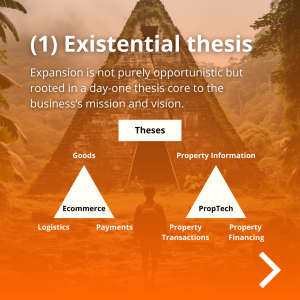
1st E of Tech Ecosystem Building: Existential thesis
Case Study on Pinhome’s thesis, as shared by CTO and co-founder Ahmed Aljunied on our podcast:
“The vision is to increase accessibility to property for better livelihood and financial inclusion.
And we had theorized that three key things were necessary to achieve this, and that would be digitizing property information, digitizing the property transaction, and digitizing financing.
In digitizing property information, this is an ongoing effort to provide a single source of truth for all property listings in Indonesia. And discovery continues to be an important use case for property seekers with a larger inventory. Discovery needs to evolve to provide a delightful experience.
In digitizing the property transaction, the complexity of a transaction continues to stay the same. So having a guide is as important as ever. And what we have found is that teaching the offline and online journey is necessary in a property transaction.
And finally, in digitizing financing, the variety of financing options continues to expand. So always keeping up to speed with new mortgage products, new combinations of variables that banks offer in their new mortgage products, and continuing to improve the financing journey. The reason why we do this is to increase transparency even more and work closely with banks to reduce time to disbursement.
So we’ve been able to validate that all these three approaches are very important to our stakeholders. But we have discovered some additional nuances along the way, due to working very closely with each of them.“
(2) Tech ecosystems are built on end-to-end monetization
Monetization strategies are not just about high net revenue streams from customers but also involves serving the supply side.
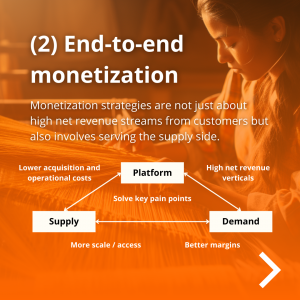
2nd E of Tech Ecosystem Building: End-to-end monetization
Case study on Pinhome’s approach to serving the supply side as well, as explained by CEO and co-founder Dara Dayu Permata on our podcast:
“Especially with our ecosystem approach, one focus is monetization strategy.
Our expansion focuses on high-net-revenue verticals that are solving key pain points of home seekers, while also serving other property stakeholders such as property developers, banks, and property agents.
Because if we’re only focusing on consumers but we don’t serve the supply side, then we might need to invest or spend a lot on acquisition costs and operational costs on the supply side. We avoid and minimize monetization strategies that require either high capex or high opex. So that’s number one.”
(3) Tech ecosystems are built on embracing partnerships
It’s impractical to build everything on your own, so build partnerships instead to diversify ways of growing supply and demand.
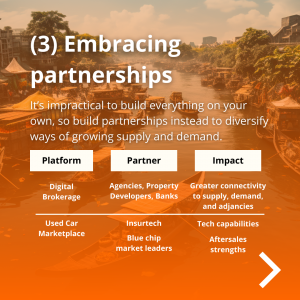
3rd E of Tech Ecosystem Building: Embracing partnerships
Case study on Carro’s approach to partnerships, as illustrated by Group CFO Ernest Chew on our podcast:
“We recognise that it’s easier to build trust in the used car ecosystem, if we can learn and work with the best partners. For instance, we have learnt significantly from MSIG and ZA Tech in strengthening our insurtech platform.
It’s very important to build partnerships that leverage on each other’s strength to deliver a strategic “win-win” outcome. For instance, how can we help our new car dealer partner to sell more new vehicles by offering used car vehicle trade-in solutions
We have learnt massively and will continue to learn, particularly around ancillaries. There are many examples. For instance, one of the areas of Jardines partnership is aftersales, where they have incredible experience build over decades.”
(4) Tech ecosystems are built on encompassing cost management
Regularly (weekly to quarterly) find cost-saving opportunities to optimize resource allocation. Monitor cashflows vis-a-vis operating drivers of each business and leverage consolidated software for better oversight.
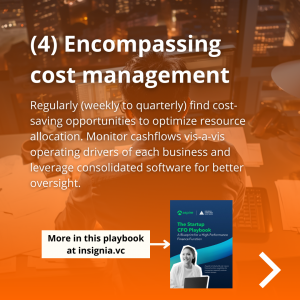
4th E of Tech Ecosystem Building: Encompassing cost management
Pinhome CEO Dara shares their approach on our podcast:
“So regular audits of financial performance, tracking key efficiency metrics, operational streamlining, vendor assessments, and resource allocation reviews—all of that is conducted regularly. Not just on a quarterly basis, but even on a weekly basis, finding and identifying cost-saving opportunities to optimize resource allocation.“
Carro CFO Ernest shares on our podcast how the nature of Carro’s business impact their approach:
“Whilst complementary and inter-linked, the operating drivers of each businesses are different…Then you multiple these 4-5 segments across all the geographies we’re in. All this whilst ensuring that OPEX is lean and there’s no duplication of costs in the various business segments. So, key point is, it’s incredibly important to build a very strong commercial understanding of building a lean business.“
Rainforest CFO and co-founder Jason Tan shares on our podcast their approach of ERP software integration:
“One of the major projects we have undertaken since late last year was the integration of ERP into Rainforest. It’s a monster of a task, as you can imagine, but I’m glad to share that we are at the tail end of the process. This will form a stronger platform for us, better from a finance and supply chain perspective, for us to operate our brands more optimally.“
More learnings on cost management in our Startup CFO playbook.
(5) Tech ecosystems are built on resilient business models on the micro level / unit economics level
Apart from low cost acquisition, it’s key to have upselling / cross-selling driving the quality of the customer relationship (high CLV, brand retention). Certain products are better suited to acquire than retain, and vice-versa.
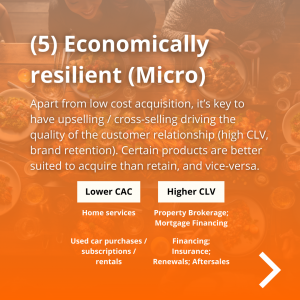
5th E of Tech Ecosystem Building: Economically resilient (Micro)
Pinhome CEO Dara shares an example use case on our podcast:
“So we always measure metrics such as CLV to CAC ratio. We want to maintain a more than 4x customer lifetime value over customer acquisition cost. Retention efforts can include a lot of other things, such as loyalty programs and customer support, to ensure satisfaction and repeat business.
We also cross-sell, right? And when we cross-sell, we acquire users with lower CAC products, such as home services, and then cross-sell them and upgrade them to high CLV products, such as brokerage or mortgage refinancing.”
Carro CFO Ernest shares their approach on our podcast:
“The idea is to cross-sell financing where we get commissions or monthly interest, cross-sell insurance and target yearly renewals, to build products and services that our customers love and capture returning customers including after sales services every 6 months, insurance renewals every year.
Essentially many of the things we do strengthens and reinforce customer lifetime value. Last quarter, our annual GP grew nearly 200% for mobility, nearly 150% for aftersales and 50% each for financing and insurance.”
Digital bank Tonik CEO and founder Greg Krasnov shares an example from their loan portfolio on our podcast:
“We’ve also created a cash loan product, which is an upsell to the good clients that we have, because once a client has proven to us that they can repay, we’ll want to offer them the next loan and the next loan…That’s a product that’s done really well for us.”
(6) Tech ecosystems are built on macro-economically resilient product stacks
Product diversification should support customers through different economic cycles or externalities.
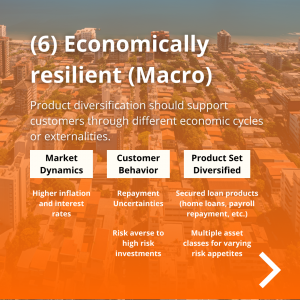
6th E of Building Tech Ecosystems: Economically resilient (Macro)
Tonik CEO Greg shares on our podcast about how the current market has impacted Tonik’s approach to building a diversified loan portfolio:
“Having a diversified product portfolio on the asset side—on the lending side—is very important to making sure the bank is sustainable through different economic cycles.
And, when times get tough, of course, you want to be more safe, more secure in the types of loans that you do. And it could mean security in terms of pledges over some assets. It could mean security in terms of the customer making a down payment against something that he’s bought with your loan, which is the case in our sales finance.
We typically require about a 20% down payment from the customer himself. Let’s say they buy a TV. We provide 80% of the financing, but 20% has to be given by the customer himself. The big loan, of course, has security on the property.
Even within the cash loan, we have different gradations. They’re not driven by security itself, but they’re driven by the demographic, because different demographics are exposed to different types of economic influences.
There are different kinds of safety levers, and what we’re trying to do right now is to balance properly. Yes, as I mentioned to you, the reason I was so keen to launch the big loan was because I could see it coming; it was not rocket science, the macro was looking bad.
When the macro is looking bad, you want to run to safety on the asset side. You want to make sure that you have products that can actually scale despite the negative macro. So payroll reduction for us, for example, is a great downside-protected mechanism because defaults would mean the employer would have to go under. And okay, we’ve had a couple of cases of employers going under; that’s not a major part of the loan.
So it’s a very stable, safe kind of source of repayment where you can go directly on the payroll. So we’re looking for those types of risk mitigants that will get us through this down cycle safely and will still allow us to scale despite the macro turbulence.“
The same concept of resilience applies to Vietnamese smart investment platform Finhay, as CEO and founder Huy Nghiem describes on our podcast:
“The whole idea of Finhay’s platform is to provide a diverse investment option for users, so they don’t have to go anywhere else. They can invest in fixed income during market turbulence and in stocks during good times. They can even balance their portfolio and invest in more traditional assets like gold with us.”
(7) Tech ecosystems are built on eclectic product discovery strategies
A company is never too mature to get back to the drawing board for product discovery.
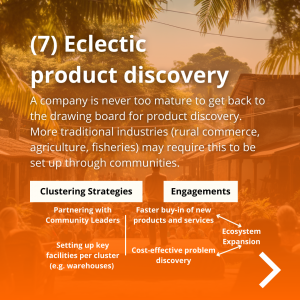
7th E of Tech Ecosystem Building: Eclectic product discovery
Flip COO Gita Prihanto explains this on our podcast:
“When we are developing a new product, the new product that we develop may not necessarily be similar to what we had earlier.
And in order to make sure that we actually can repeat that success, we need to take a step back and really learn again what right now exactly the user needs, what is it that is available in the market, and what is still missing in terms of features or solutions and stuff.
We really need to literally get on the whiteboard and draw again, have a discussion, and problem-solve what is exactly the new solution that caters towards a completely different set of, for example, products. And in order to do it, we cannot simply just copy what we did in our core product.“
More traditional industries (rural commerce, agriculture, fisheries) may require this to be set up through communities.
Elevarm CTO and co-founder Febi Agil Ifidillah explains this on our podcast:
“We build an ecosystem that consists of on-time facilities. So we leverage the power of being present right in the heart of the farming area through on-facility, which we call AgriPoint.
So that’s one of our facilities, which provides high-quality active inputs to post-solutions marketing, good solutions, access to uncomplicated financing, and of course, a knowledge center as well for small projects. And over time, the kind of facilities that we built within the cluster has also evolved, including currently building nurseries, partnering with local growers as well to build seed-link centers, etc. So it’s bottom-up problem discovery and also solutions that we deploy with each cluster.”
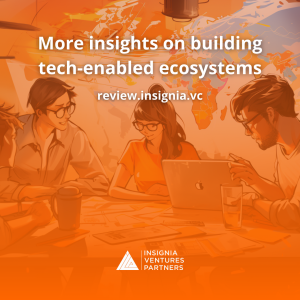
More insights on building tech enabled ecosystems
Paulo Joquiño is a writer and content producer for tech companies, and co-author of the book Navigating ASEANnovation. He is currently Editor of Insignia Business Review, the official publication of Insignia Ventures Partners, and senior content strategist for the venture capital firm, where he started right after graduation. As a university student, he took up multiple work opportunities in content and marketing for startups in Asia. These included interning as an associate at G3 Partners, a Seoul-based marketing agency for tech startups, running tech community engagements at coworking space and business community, ASPACE Philippines, and interning at workspace marketplace FlySpaces. He graduated with a BS Management Engineering at Ateneo de Manila University in 2019.